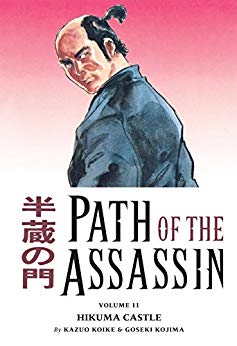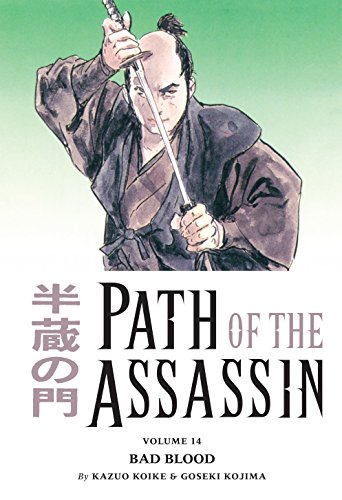Manga Review: Path of the Assassin, Volumes 11 & 14 by Kazuo Koike & Goseki Kojima
It is the last years of the Warring States period of Japanese history. In these volumes, we follow the adventures of Hattori Hanzo, greatest of the Iga ninja (in this interpretation) and vassal of Tokugawa Ieyasu, who would become shogun of Japan. While these stories feature historical persons and often actual historical events, they’ve been heavily fictionalized. Note that this review may have SPOILERS for previous volumes.

Volume 11. “Hikuma Castle”, opens with Hanzo in desperate battle with the kunoichi (female ninja) Kuronami (“black wave”) who challenges him to a fight using only their naked bodies. Hanzo is totally up for this, but is at a momentary disadvantage when it turns out Kuronami has used spider goo to turn her hair into a deadly weapon. Hanzo still manages to win this sexy battle.
On the wider political front, Nobunaga has managed to consolidate his power by defeating most opposing factions, but is still having trouble with the Miyoshi alliance. He conceives a plan modeled after a colicky baby; appear to abandon shogun Yoshiaki in the Kyoto capital for the winter, tricking the Miyoshi alliance into taking the field. Since Nobunaga hasn’t actually gone all the way home, he can then hurry back and crush the Miyoshi.
This succeeds, but Tokugawa now wants to proceed against his own enemies, first by taking Hikuma Castle. But he needs to know if the shogun has warned Azai of his plans. And that’s where Hanzo comes in again. Allied with ninja in the service of Hideyoshi, Hanzo must infiltrate enemy territory and find a way to report back on their intentions. This requires a battle of wits with Azai’s ninja spies.
Hanzo also assists in the actual battle, and as a gesture of respect, Azai warns him that an assassin who’s an expert in firearms has been sent after Nobunaga–Azai may be a rebel, but he’s no traitor!
The volume ends with the backstory of Zenjubo the assassin, setting up his confrontation with Hanzo.

Volume 14, “Bad Blood”, picks up a few years later. Takeda Shingen, leader of the Takeda clan, has died. His son Katsuyori wants to proceed with battle against Tokugawa by pretending his father is still alive, but Shingen’s will forbids it, mandating instead that Katsuyori mourn for three years to allow another chance at victory to open up. Reluctantly, the son agrees, but commissions The Three Court Ladies, deadly sorceresses, to assassinate Tokugawa Ieyasu.
Masters of hypnotic illusion, the Ladies stymie even Hanzo’s attempts to stop them before they can reach the lord of Tokugawa. But at last Hanzo figures out a sexy solution!
Ieyasu’s son Takechiyo is finally to have his coming of age ceremony. He’s grown into a fine-looking teenager, strong and tall…but not resembling his short, round father much at all. Ieyasu’s wife is known to be chafing in her political marriage; how long has this been going on? Could Takechiyo (soon to become Nobuyasu) have another father?
Meanwhile, Hanzo decides to get his own household in order by having all three of his women, including his wife, his lover, and the mother of his son, all under the same roof. Time for some hot foursomes!
Takeda Katsuyori is still infuriated by his mandated lack of action. But now he has a new ally, the master spy and manipulator Sasuke. Sasuke infiltrates the Tokugawa camp and offers Ieyasu’s wife a tempting and sexy bargain that will rid her of her hated husband and propel her son (and her) into power.
While Hanzo realizes Sasuke’s presence, he misjudges what the other ninja has as an ultimate goal, setting up a tragic failure–but that’s for the final volume!
This series is by the same team that brought us Lone Wolf and Cub and has many of the same strong points. Effective art, detailed research, exciting action scenes. It adds actual historical events starring fascinating characters. Historical terms are common, requiring a glossary. (The characters we call ninja are usually referred to as suppa in the text.)
On the other hand, it also adds a lot more on-page sex, including several shades of rape. Some of it advances the plot, but other scenes come across as gratuitous, the equivalent of a strip joint scene in an American action movie. The narrative treatment also goes with the cultural norm that men who have multiple partners are at worst excusable and often awesome, but women who have more than one partner are evil.
Presuming you can put up with the sex scenes (or even like them), this series is a fascinating historical drama.

